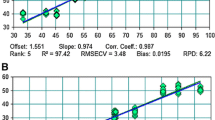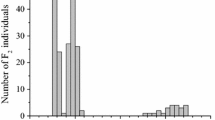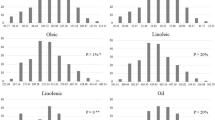Abstract
Oils with high oleic acid content are in great demand because they have optimal properties for food and non-food uses. Two different levels of high oleic acid content (>75 and >84%) have been reported in safflower (Carthamus tinctorius L.). The trait is mainly controlled by partially recessive alleles at a major gene Ol, but the highest levels have been attributed to modifying genes. The objectives of this research were to map the Ol locus and modifying genes involved in oleic acid content of safflower seeds and to determine the nature of Ol through a candidate gene approach. Two F2 mapping populations from the nuclear male-sterile line CL-1 and the high oleic acid lines CR-6 (>75% oleic acid) and CR-9 (>84%) were developed and phenotyped for oleic acid content at the F2 and F3 seed level. A genetic linkage map comprising 15 linkage groups and 116 random amplified polymorphic DNA, simple sequence repeat (SSR), and sequence-characterized amplified regions marker loci was constructed for the CL-1 × CR-9 population. The Ol gene was mapped to linkage group (LG) T3 tightly linked to the SSR marker ct365, which was confirmed in the CL-1 × CR-6 population. Additionally, a quantitative trait locus with a minor effect on increasing oleic acid content was identified on LG T2. The candidate gene approach indicated that an oleoyl-phosphatidylcholine desaturase FAD2-1 locus underlies the Ol gene. Both the genetic information and the markers developed in this research will contribute to marker-assisted selection for high oleic acid content in safflower.



Similar content being viewed by others
References
Amini F, Saeidi G, Arzani A (2008) Study of genetic diversity in safflower genotypes using agro-morphological traits and RAPD markers. Euphytica 163:21–30
Beló A, Zheng P, Luck S, Shen B, Meyer DJ, Li B, Tingey S, Rafalski A (2008) Whole genome scan detects an allelic variant of fad2 associated with increased oleic acid levels in maize. Mol Genet Genom 279:1–10
Bohn M, Khairallah MM, González-de-León D, Hoisington DA, Utz HF, Deutsch JA, Jewell DC, Mihm JA, Melchinger AE (1996) QTL mapping in tropical maize: I. Genomic regions affecting leaf feeding resistance to sugarcane borer and other traits. Crop Sci 36:1352–1361
Briggs FD, Knowles PF (1967) Introduction to plant breeding. Reinhold Publishing Corporation, New York
Chapman MA, Burke JM (2007) DNA sequence diversity and the origin of cultivated safflower (Carthamus tinctorius L.; Asteraceae). BMC Plant Biol 7:60. doi:10.1186/1471-2229-7-60
Chapman MA, Hvala J, Strever J, Matvienko M, Kozik A, Michelmore RW, Tang S, Knapp SJ, Burke JM (2009) Development, polymorphism, and cross-taxon utility of EST-SSR markers from safflower (Carthamus tinctorius L.). Theor Appl Genet 120:85–91
Churchill GA, Doerge RW (1994) Empirical threshold values for quantitative trait mapping. Genetics 138:963–971
Dajue L, Mündel H-H (1996) Safflower (Carthamus tinctorius L.). Monograph n. 7, Promoting the Conservation and Use of Underutilized and Neglected Crops. Institut für Pflanzengenetik und Kulturpflanzenzüchtung (IPK), Gatersleben, Germany and International Plant Genetic Resources Institute (IPGRI), Rome, Italy
Falconer DS (1989) Introduction to quantitative genetics, 3rd edn. Longman Group, London
Falentin C, Brégeon M, Lucas MO, Deschamps M, Leprince F, Fournier MT, Delourne R, Renard M (2007) Identification of fad2 mutations and development of allele-specific markers for high oleic acid content in rapeseed (Brassica napus L.). In: Proceedings of 12th international rapeseed conference, Wuhan, vol II, pp 117–119
Fernández-Martínez JM, Jiménez A, Domínguez J, García JM, Garcés R, Mancha M (1989) Genetic analysis of the high oleic content in cultivated sunflower (Helianthus annuus L.). Euphytica 41:39–51
Fernández-Martínez JM, del Rio M, de Haro A (1993) Survey of safflower (Carthamus tinctorius L.) germplasm for variants in fatty acid composition and other seed characters. Euphytica 69:115–122
Fernández-Martínez JM, Velasco L, Pérez-Vich B (2004) Progress in the genetic modification of sunflower oil quality. In: Proceedings of 16th international sunflower conference, Fargo, ND, vol I, pp 1–14
Futehally S, Knowles PF (1981) Inheritance of very high levels of linoleic acid in an introduction of safflower (Carthamus tinctorius L.) from Portugal. In: Knowles PF (ed) Proceedings of 1st international safflower conference, Davis, CA
Garcés R, Mancha M (1993) One-step lipid extraction and fatty acid methyl esters preparation from fresh plant tissues. Anal Biochem 211:139–143
García-Moreno MJ, Fernández-Martínez JM, Velasco L, Pérez-Vich B (2011) Molecular tagging and candidate gene analysis of the high gamma-tocopherol trait in safflower (Carthamus tinctorius L.). Mol Breed 28:367–379
Guan L-L, Xu Y-W, Wang Y-B, Chen L, Shao J-F, Wu W (2011a) Isolation and characterization of a temperature-regulated microsomal oleate desaturase gene (CtFAD2-1) from safflower (Carthamus tinctorius L.). Plant Mol Biol Rep. doi:10.1007/s11105-011-0349-7
Guan L-L, Wang Y-B, Shen H, Hou K, Xu Y-W, Wu W (2011b) Molecular cloning and expression analysis of genes encoding two microsomal oleate desaturases (FAD2) from safflower (Carthamus tinctorius L.). Plant Mol Biol Rep. doi:10.1007/s11105-011-0322-5
Hamdan YAS, Velasco L, Pérez-Vich B (2008) Development of SCAR markers linked to male sterility and very high linoleic acid content in safflower. Mol Breed 22:385–393
Hamdan YAS, Pérez-Vich B, Velasco L, Fernández-Martínez JM (2009a) Inheritance of high oleic acid content in safflower. Euphytica 168:61–69
Hamdan YAS, Pérez-Vich B, Fernández-Martínez JM, Velasco L (2009b) Novel safflower germplasm with increased saturated fatty acid content. Crop Sci 49:127–132
Hamdan YAS, García-Moreno MJ, Redondo-Nevado J, Velasco L, Pérez-Vich B (2011) Development and characterization of genomic microsatellite markers in safflower (Carthamus tinctorius L.). Plant Breed 130:237–241
Heaton TC, Knowles PF (1982) Inheritance of male sterility in safflower. Crop Sci 22:520–522
Hongtrakul V, Slabaugh MB, Knapp SJ (1998) A seed specific Δ-12 oleate desaturase gene is duplicated, rearranged and weakly expressed in high oleic acid sunflower lines. Crop Sci 38:1245–1249
Hu X, Sullivan-Gilbert M, Gupta M, Thompson SA (2006) Mapping of the loci controlling oleic and linolenic acid contents and development of fad2 and fad3 allele-specific markers in canola (Brassica napus L.). Theor Appl Genet 113:497–507
Johnson RC, Kisha TJ, Evans MA (2007) Characterizing safflower germplasm with AFLP molecular markers. Crop Sci 47:1728–1736
Knowles PF (1972) The plant geneticist’s contribution towards changing lipid and amino acid composition of safflower. J Am Oil Chem Soc 49:27–29
Knowles PF (1989) Safflower. In: Downey RK, Röbbelen G, Ashri A (eds) Oil crops of the world. McGraw-Hill, New York, pp 363–374
Knowles PF, Hill AB (1964) Inheritance of fatty acid content in the seed oil of a safflower introduction from Iran. Crop Sci 4:406–409
Lacombe S, Souyris I, Bervillé AJ (2009) An insertion of oleate desaturase homologous sequence silences via siRNA the functional gene leading to high oleic acid content in sunflower seed oil. Mol Genet Genom 281:43–54
Lander ES, Green P, Abrahamson J, Barlow A, Daly MJ, Lincoln SE, Newburg L (1987) MAPMAKER: an interactive computer package for constructing primary genetic linkage maps of experimental and natural populations. Genomics 1:174–181
Martínez-Rivas JM, Sperling P, Lühs W, Heinz E (2001) Spatial and temporal regulation of three different microsomal oleate desaturase genes (FAD2) from normal-type and high-oleic varieties of sunflower (Helianthus annuus L.). Mol Breed 8:159–168
Mayerhofer R, Archibald C, Bowles V, Good AG (2010) Development of molecular markers and linkage maps for the Carthamus species C. tinctorius and C. oxyacanthus. Genome 53:266–276
Mensink RP, Katan MB (1989) Effect of a diet enriched with monounsaturated or polyunsaturated fatty acids on levels of low-density and high-density lipoprotein cholesterol in healthy women and men. N Engl J Med 321:436–441
Okuley J, Lightner J, Feldmann K, Yadav N, Lark E, Browse J (1994) Arabidopsis FAD2 gene encodes the enzyme that is essential for polyunsaturated lipid synthesis. Plant Cell 6:147–158
Pérez-Vich B, Fernández-Martinez JM, Grondona M, Knapp SJ, Berry ST (2002) Stearoyl-ACP and oleoyl-PC desaturase genes cosegregate with quantitative trait loci underlying stearic and oleic acid mutant phenotypes in sunflower. Theor Appl Genet 104:338–349
Pérez-Vich B, Fernández-Martinez JM, Leon A, Knapp SJ, Berry ST (2004) Mapping minor QTL for increased stearic acid content in sunflower seed oil. Mol Breed 13:313–322
Pham A-T, Lee J-D, Shannon JG, Bilyeu K (2010) Mutant alleles of FAD2-1A and FAD2-1B combine to produce soybeans with the high oleic acid seed oil trait. BMC Plant Biol 10:195. doi:10.1186/1471-2229-10-195
Pham A-T, Lee J-D, Shannon JG, Bilyeu K (2011) A novel FAD2-1 A allele in a soybean plant introduction offers an alternate means to produce soybean seed oil with 85% oleic acid content. Theor Appl Genet 123:793–802
Ravikumar RL, Shiva Priya M, Patil BS, Satish D (2005) DNA profiling and fingerprinting of selected mutants for marker analysis in safflower (Carthamus tinctorius L.) In: Essendal E (ed) Proceedings of 6th international safflower conference, Istanbul
Rogers SO, Bendich AJ (1985) Extraction of DNA from milligram amounts of fresh, herbarium and mummified plant tissues. Plant Mol Biol 5:69–76
Scheffler JA, Sharpe AG, Schmidt H, Sperling P, Parkin IAP, Lühs W, Lydiate DJ, Heinz E (1997) Dasaturase multigene families of Brassica napus arose through genome duplication. Theor Appl Genet 94:583–591
Schlueter JA, Vasylenko-Sanders IF, Deshpande S, Yi J, Siegfried M, Roe BA, Schlueter SD, Scheffler BE, Shoemaker RC (2007) The FAD2 gene family of soybean: Insights into the structural and functional divergence of a paleopolyploid genome. Crop Sci 47(Supplement_1):S-14-26
Schuppert G, Tang S, Slabaugh M, Knapp SJ (2006) The sunflower high-oleic mutant Ol carries variable tandem repeats of FAD2-1, a seed-specific oleoyl-phosphatidyl choline desaturase. Mol Breed 17:241–256
Sehgal D, Raina SN (2005) Genotyping safflower (Carthamus tinctorius) cultivars by DNA fingerprints. Euphytica 146:67–76
Singh V, Nimbkar N (2007) Safflower. In: Singh RJ (ed) Genetic resources, chromosome engineering and crop improvement : oilseed crops, vol 4. CRC Press, Boca Raton, pp 167–194
Urie AL (1985) Inheritance of high oleic acid in sunflower. Crop Sci 25:986–989
Utz HF, Melchinger AE (1996) PLABQTL: a program for composite interval mapping of QTL. J Quant Trait Loci 2:1
Vilatersana R, Garnatje T, Susanna A, Garciajacas N (2005) Taxonomic problems in Carthamus: RAPD markers and sectional classification. Bot J Linn Soc 147:375–383
Voorrips RE (2002) Mapchart: software for the graphical presentation of linkage map and QTL. J Hered 93:77–78
Yang Y-X, Wu W, Zheng Y-L, Chen L, Liu R-J, Huang C-Y (2007) Genetic diversity and relationships among safflower (Carthamus tinctorius L.) analyzed by inter-simple sequence repeats (ISSRs). Genet Resour Crop Evol 54:1043–1051
Yazdi-Samadi B, Maali-Amiri R, Ghannadha MR, Abd-Mishani C (2001) Detection of DNA polymorphism in landrace populations of safflower in Iran using RAPD-PCR technique. In: Bergman JW, Mündel HH (eds) Proceedings of 5th international safflower conference, Williston, ND and Sidney
Yodice R (1990) Nutritional and stability characteristics of high oleic sunflower seed oil. Fat Sci Technol 92:121–126
Zeng ZB (1994) Precision mapping of quantitative trait loci. Genetics 136:1457–1468
Zhang Z, Guo M, Zhang J (2009) Identification of AFLP fragments linked to hydroxysafflor yellow A in Flos Carthami and conversion to a SCAR marker for rapid selection. Mol Breed 23:229–237
Acknowledgments
Y.A.S. Hamdan was the recipient of a grant from the Agencia Española de Cooperación Internacional (AECI). The research was funded by Junta de Andalucía support program to research groups (PAI-AGR-118).
Author information
Authors and Affiliations
Corresponding author
Additional information
Yamen A. S. Hamdan and María J. García-Moreno contributed equally to this work.
Rights and permissions
About this article
Cite this article
Hamdan, Y.A.S., García-Moreno, M.J., Fernández-Martínez, J.M. et al. Mapping of major and modifying genes for high oleic acid content in safflower. Mol Breeding 30, 1279–1293 (2012). https://doi.org/10.1007/s11032-012-9714-y
Received:
Accepted:
Published:
Issue Date:
DOI: https://doi.org/10.1007/s11032-012-9714-y




